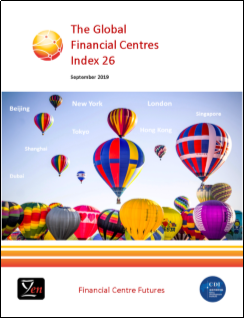Authors
Mark Yeandle, Mike Wardle, Professor Michael Mainelli
Published by
Long Finance & Global Financial Centres (September 2019), 55 pages. Produced by Z/Yen in Partnership with CDI.
Share on social media:


The Global Financial Centres Index 26
The twenty-sixth edition of the Global Financial Centres Index (GFCI 26) was published on 19 September 2019. GFCI 26 provides evaluations of future competitiveness and rankings for 104 major financial centres around the world. The GFCI serves as a valuable reference for policy and investment decision-makers.
China Development Institute (CDI) in Shenzhen and Z/Yen Partners in London collaborate in producing the GFCI. The GFCI is updated and published every March and September, and receives considerable attention from the global financial community.
114 financial centres were researched for GFCI 26 of which 104 are now in the main index. The GFCI is compiled using 134 instrumental factors. These quantitative measures are provided by third parties including the World Bank, the Economist Intelligence Unit, the OECD and the United Nations.
The instrumental factors are combined with financial centre assessments provided by respondents to the GFCI online questionnaire. GFCI 26 uses 32,227 assessments from 3,360 respondents.
The Results Of GFCI 26 Include:
- New York extended its lead over London to 17 points. Strong performances from other centres, in particular Paris, put London’s second place in the index at risk next time. If London and Paris have similar falls and rises in the ratings for GFCI 27, London would be reduced to a two point lead over Paris and lie behind Shanghai.
- The new FinTech index, published for the first time alongside the GFCI, is dominated by Chinese centres taking five of the top seven places in the index, led by Beijing and Shanghai. New York, London, Singapore, San Francisco, and Chicago also feature in the top ten for FinTech.
- Trade wars, geopolitical unrest, and Brexit are introducing significant adjustments to medium-term perceptions.
Other News
- Twelve centres rose 10 or more places in the rankings and ten fell 10 or more places.
- Performance across the index showed slightly reduced confidence, with the overall ratings falling around 2.5% from GFCI 25. Thirty-one of the 104 centres fell in the ratings, including all of the top five centres.
- Seven of the top ten places in the index are now taken by Asia/Pacific centres, continuing the region’s strong performance over recent years.
Leading Centres
- New York retains its first place in the index, extending its lead over London from seven to 17 points. Hong Kong is now only two points behind London. Singapore and Shanghai remain in fourth and fifth position. All five top centres fell in the ratings in GFCI 26.
- Shenzhen, Dubai, and Sydney entered the top 10, easing out Toronto, Zurich, and Frankfurt.
- Within the top 30 centres, Paris has performed well, rising 10 places to 17th.
Western Europe
- Following a good performance in GFCI 25, this region had a more mixed performance in GFCI 26, with 15 centres rising in the rankings and 13 falling.
Asia/Pacific
- Asia/Pacific Centres performed well, with 20 of the 27 centres in the region either retaining or improving their position in the rankings. Nanjing entered the index for the first time.
- There were significant rises for Wellington, Mumbai, and Chengdu.
North America
- North American centres had mixed fortunes in GFCI 26, with Canadian centres dropping back following their improved performance in GFCI 25, while US centres generally improved their rankings and ratings.
- Seven out of the ten North American centres in the index are in the top 20.
Eastern Europe & Central Asia
- Nur-Sultan (formerly Astana) retained its top ranking in the Eastern Europe & Central Asia region, consolidating its position despite being a recently-formed financial centre.
- All but two of the 16 centres in the region improved their rating, with nine centres improving their overall ranking.
Middle East & Africa
- Dubai, Casablanca, Tel Aviv, and Doha continued to rise in the index, with Dubai entering the top ten in the world. There were significant improvements for Mauritius, Bahrain, and Nairobi.
Latin America & The Caribbean
- The Bahamas and Buenos Aries performed well in GFCI 26, rising 11 and ten places in the rankings respectively.
Island Centres
The British Crown Dependencies’ performance dipped, with the Isle of Man down five places in the rankings, Jersey falling 12, and Guernsey continuing its rapid decline in the index, dropping 17 places following its 15-place fall in GFCI 25.




